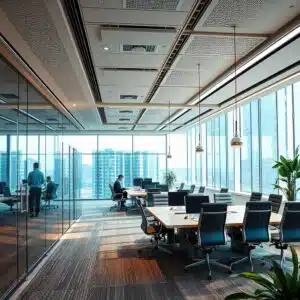As the real estate industry continues to evolve, we at Ironsides Group are witnessing firsthand how landmark developments like 2 World Trade Center are shaping the future of Manhattan’s skyline. This project, spearheaded by Larry Silverstein and potentially anchored by American Express, is more than just a building. It’s a symbol of resilience, innovation, and New York City’s undying spirit.
In this deep dive, we’ll explore the ongoing negotiations between Silverstein Properties and American Express, why we think this development is crucial for the future of Manhattan real estate, and how the ripple effects of such projects can impact commercial real estate investing strategies. Let’s start by understanding the key players involved and the significance of this potential partnership.
The Key Players: Larry Silverstein and American Express
Larry Silverstein, the 93-year-old developer behind the World Trade Center complex, has been on a mission to complete 2 World Trade Center for years. Despite several false starts with potential tenants, including News Corp and Citigroup, Silverstein remains determined to bring his vision to life.
As we at Ironsides Group follow this development, we see the significance of a major financial player like American Express potentially anchoring this skyscraper.
For American Express, a move to 2 WTC could signify a commitment to modern office spaces that are more sustainable, flexible, and future-proofed.

Why 2 World Trade Center Matters for Manhattan
2 World Trade Center isn’t just another building in New York City. It’s the final piece in the redevelopment of the World Trade Center site, and its completion will mark a significant milestone in the city’s commercial real estate landscape.
We at Ironsides Group believe that this tower represents the future of office spaces—spaces designed with flexibility, sustainability, and post-pandemic realities in mind.
As part of our cutting-edge technology services, we’ve observed how technological advancements have redefined the functionality of commercial spaces. The all-electric design of 2 WTC, along with ample outdoor space and flexible interiors, is a perfect example of where the future of real estate is headed.
The Ripple Effect on Commercial Real Estate
The potential deal between Silverstein Properties and American Express doesn’t just affect these two giants. It sends a signal to the rest of the industry about the importance of strategic partnerships and long-term investments in prime real estate locations.
For example, consider our Quadrant Approach to Commercial Real Estate Investing, which emphasizes the value of high-quality, well-located properties. A project like 2 WTC fits squarely into the quadrant that focuses on high-growth potential and long-term stability.
Furthermore, as economic trends continue to shift, particularly with slower GDP growth and fluctuating interest rates, the role of prime real estate in portfolios becomes even more critical.
Manhattan’s commercial real estate, especially at the World Trade Center, remains a highly coveted asset.
What American Express Stands to Gain
American Express’s potential move to 2 WTC could also symbolize a broader trend in corporate relocations. With its current headquarters at 200 Vesey Street, AmEx is weighing the costs and benefits of renovating its existing space versus moving to a state-of-the-art tower.
At Ironsides Group, we’ve seen how companies are increasingly opting for modernized spaces that cater to a hybrid workforce. AmEx’s decision to relocate could reflect this trend, as employees now demand better amenities, flexibility, and sustainable practices in their workplaces.
“It’s no longer just about location; it’s about creating an environment that meets the changing needs of today’s workforce.” — Andre Granello, CEO, Ironsides Group
The Role of Technology in Shaping the Future of Skyscrapers
Technology is at the heart of the modern office space, and 2 World Trade Center is no exception. As an industrial solutions provider, we have observed how cutting-edge tech can transform a building’s value proposition.
From energy-efficient systems to AI-driven security solutions, the potential for innovation at 2 WTC is immense.

Internal and External Links: Building Connections
As we’ve discussed, one of the most important aspects of modern commercial real estate is the ability to adapt to current and future trends. Silverstein’s 2 WTC embodies that adaptability, and it’s essential for businesses to make strategic investments in prime real estate to secure their future.
You can read more about the economic implications of such investments in our detailed analysis on the U.S. Real Estate Market Outlook 2024.
On the other hand, Barry Sternlicht’s analysis sheds light on how Federal Reserve policies might influence future investments in iconic towers like 2 WTC.
The Future of Manhattan’s Skyline
In conclusion, the potential American Express and Silverstein partnership at 2 World Trade Center marks a pivotal moment for the future of Manhattan.
It’s not just about a building; it’s about rethinking what corporate headquarters mean in a post-pandemic world. We at Ironsides Group believe that this development will inspire further innovation and growth in commercial real estate.
Stay tuned for more updates on this groundbreaking project, and if you’re considering commercial real estate investments, contact us today to explore how we can help you navigate this dynamic market.
